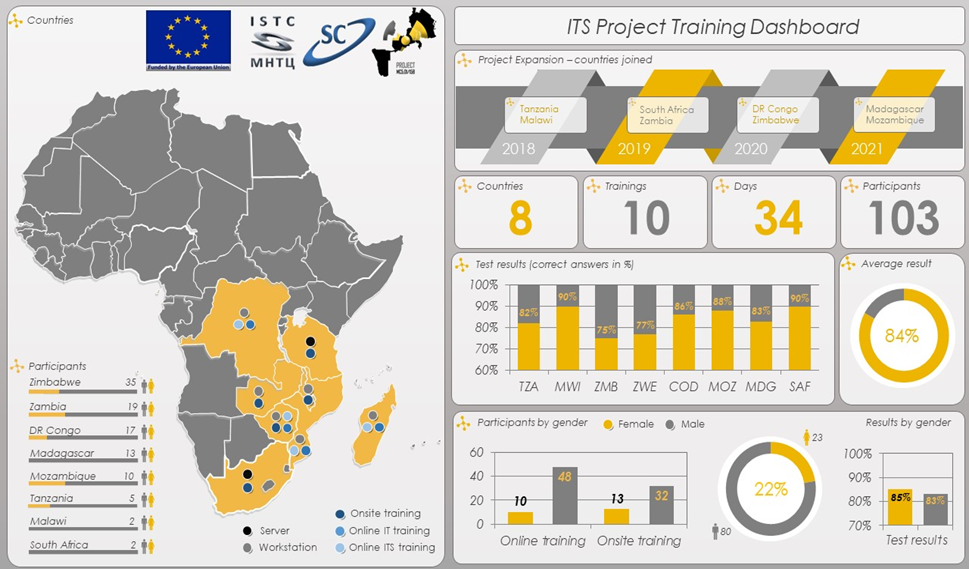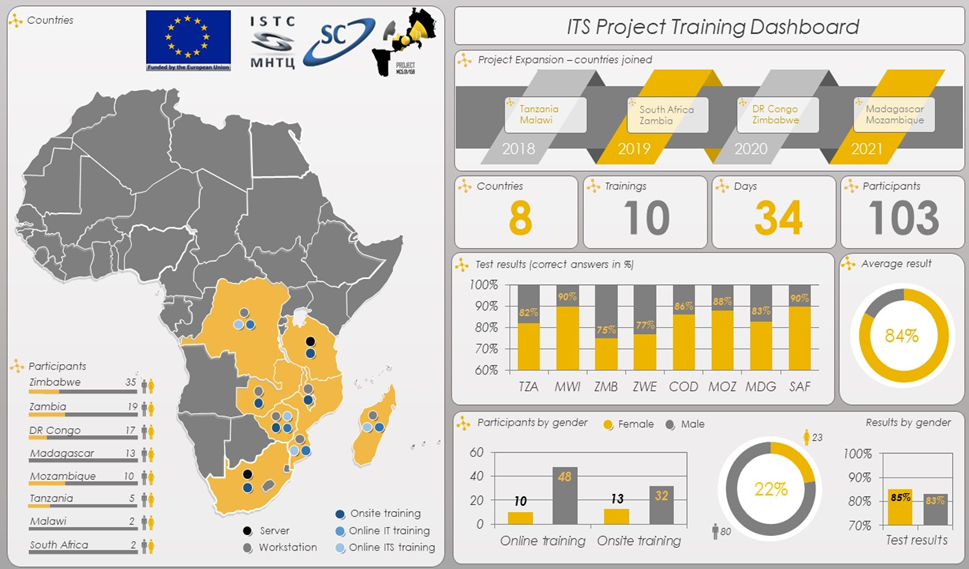103 Women and Men from 8 Countries trained to use a web-based system to monitor the transportation of Radioactive Materials across Southern African States


As of June 2021, the Software Company Ltd. has completed 10 training sessions both in-person and online, with a total of 103 participants from 8 countries, on using the Information Tracking System, thus continuing the implementation phase of Project MC 5.01 15B Support to Southern African States in Nuclear Safety and Safeguards. The trainings strengthen the human and institutional capacities for credible monitoring with a web-based tool the transportation of Uranium Ore Concentrate through the participating countries’ territories. All training sessions ended with a multiple-choice test; the average test result is 84 per cent. This score serves as an evaluation for the collaborative work of both trainees and trainers and speaks for reliable project results. We observe with delight the growing engagement of the younger generation of nuclear specialists, and especially the female representatives from various organizations throughout SADC countries, assert the experts from Software Company who have just submitted to ISTC a comprehensive report about their recent work.
The Information Tracking System (ITS) – a key component of Project MC 5.01 15B – was conceived as a web-based platform for data exchange and monitoring the transportation of Uranium Ore Concentrate and other radioactive materials within and across the borders of several southern African states. The ITS is now available for use in DR Congo, Madagascar, Malawi, Mozambique, South Africa, Tanzania, Zambia, and Zimbabwe. This forms a congruent area across the Southern part of the African continent in which transport of radioactive material may be monitored in real-time.
Since the global health pandemic and the inability to travel continue to hinder the implementation of the trainings in person, ISTC and Software Company took on the task of performing the training sessions online via the Zoom platform thus ensuring more learning time to counterbalance the lack of face-to-face communication. The trainings for Madagascar, Mozambique, DR Congo, and Zimbabwe took place between March and May and were all divided into two parts – a two-day preliminary and a five-day regular training course. Although trainings were executed solely as online meetings, reads the report, the Software Company was able to form fruitful partnerships with the participants. It also collected exciting feedback from the trainees and discussed future modifications in the ITS platform in line with the needs of the local stakeholders. In June, all participants will receive thorough instructions on how to set up their accounts and use the main server in TAEC, Tanzania, so that the implementation of ITS can be completed, and the stakeholders can benefit from the ITS full potential to track the transportation of radioactive materials within and beyond national borders.
The 2021 training cycle features interesting details. In three of the participating countries – DR Congo, Zambia, and Mozambique – the local partners arranged simulation of actual shipment of radioactive materials. Vehicles with ITS trackers travelled along predefined routes in the outskirts of Kinshasa, Lusaka, and Maputo. The trainees were thus able to test how the IT system works in real-time.
In Madagascar, the list of trainees included two specific groups of participants: experts from the Maritime Information Fusion Centre (CFIM), a key institution that comprises representatives of several government agencies with a stake in CBRN security; and trainees from mining and transportation companies that serve as consignees in the radioactive material delivery chain. CFIM is the designated focal point for the Indian Ocean Regional Information System (IORIS) platform, an EU-funded web-based maritime coordination and information-sharing tool available for regional and national multi-agency use. IORIS provides maritime centres with a means to plan and coordinate maritime operations, also offering command and control functions for crisis/incident management. Information Fusion centres are also able to use the tool to share information and distribute enriched data. Therefore, through CFIM, ITS could establish a link between the road and sea transport that may facilitate complementarity of action and multiply its efficiency. Madagascar has no reactor or nuclear power generations. It uses radiological applications in medicine, industry, and research. In recent years, the mining and export of monazite ores have increased. The operators from the mining and transport companies are mostly responsible to fulfil all requirements for secure and safe transportation of sensitive materials, therefore, their involvement as stakeholders in the ITS application is extremely important. Dr Joseph Lucien Zafimanjato, Director, Radiological Safety and Nuclear Security, the Institut National des Sciences et Techniques Nucléaires (INSTN), thanked the European Union, ISTC and Software Company for the useful assistance and valuable technical support that will increase both the human resources capacity and the technical capability of Madagascar. Using the two monitoring systems – inland, ITS, and maritime, IORIS, – on the territory of the island could allow the country to play increasingly important regional role in nuclear safety and security.
Handing over Certificates to the participants who completed their trainings and final tests, Nikolay Palov, the CEO of the Software Company assured that his colleagues are available to provide support to all partners and ensure the smooth use of the Information Tracking System.

